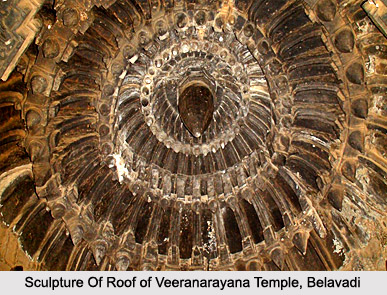
Temple follows the Hoysala temple building idiom. Located in Belavadi the temple is a 'trikuta' or three shrined. Trikuta or three shrined temple is a common feature of Hoysala temples.
The usual building material chlorite schist or soapstone has been used for the Veeranarayana Temple built by Veera Ballala II. The most striking feature about the architecture of the temple is that two of the shrines face each other. They have a common open mandapa that has 37 bays.
Each of the shrines has a complete tower on its top. These superstructures are known to be the largest examples of Hoysala architecture.
The third shrine is quite ancient with both closed and open mandapas. The closed one has 13 bays and the open mandapa has 9 bays. The central shrine is situated at the end of the hall. This shrine has all the architectural elements of the Hoysala.

 As is the Hoysala feature the inner wall is simply made up. But the roof is ornately decorated. It has 59 bays and the pillars constructed lathe turned. Some others have carvings on them. It is interesting to note that the ones that bear sculptures have been constructed manually. The temple panels consist of the sculpted figures of Hindu deities and their attendants. Another sculptural element is the friezes or mouldings on the walls.
As is the Hoysala feature the inner wall is simply made up. But the roof is ornately decorated. It has 59 bays and the pillars constructed lathe turned. Some others have carvings on them. It is interesting to note that the ones that bear sculptures have been constructed manually. The temple panels consist of the sculpted figures of Hindu deities and their attendants. Another sculptural element is the friezes or mouldings on the walls.Read more :Sculpture Of Veeranarayana Temple, Belavadi, Hoysala Sculpture

